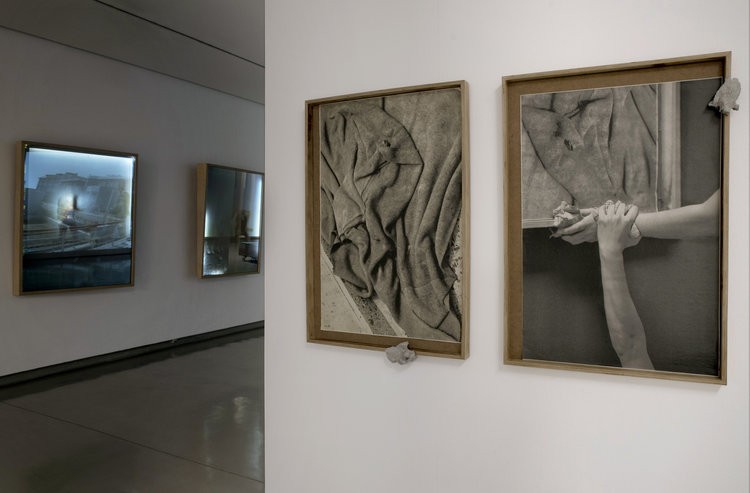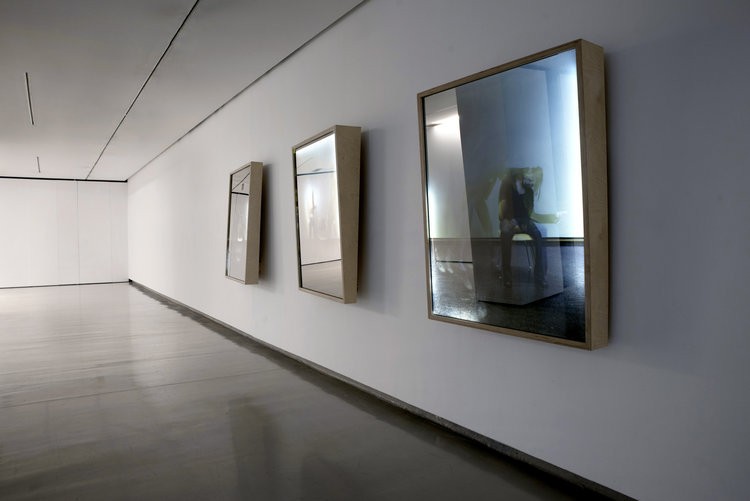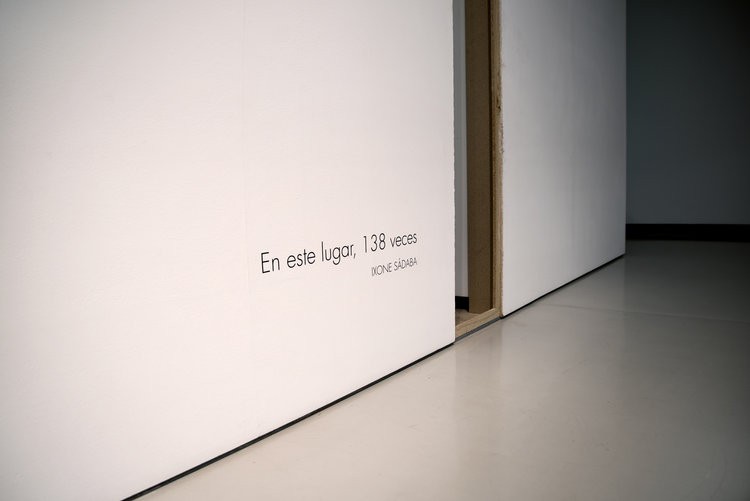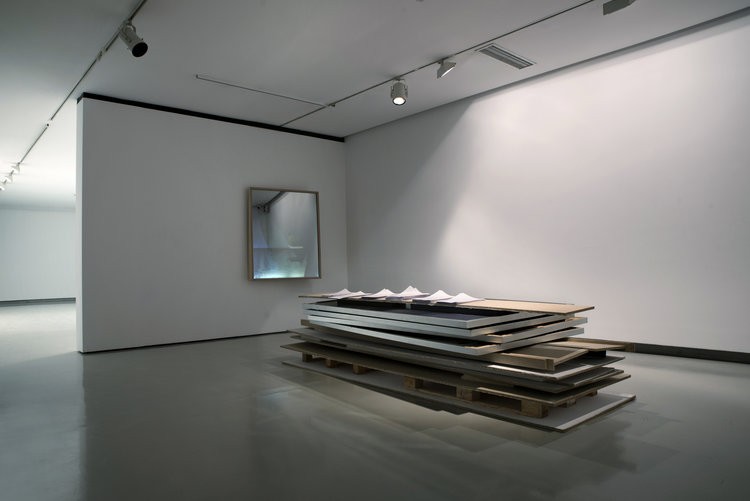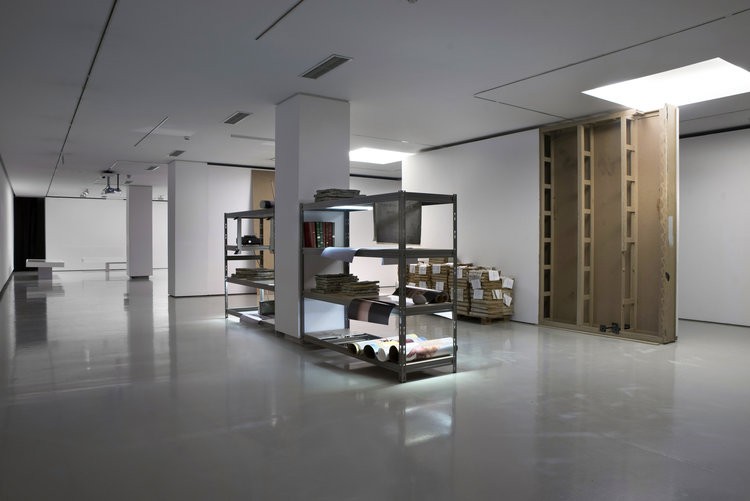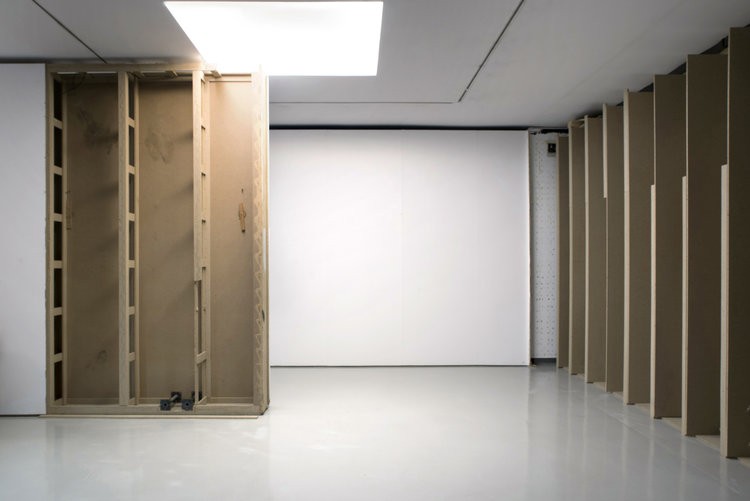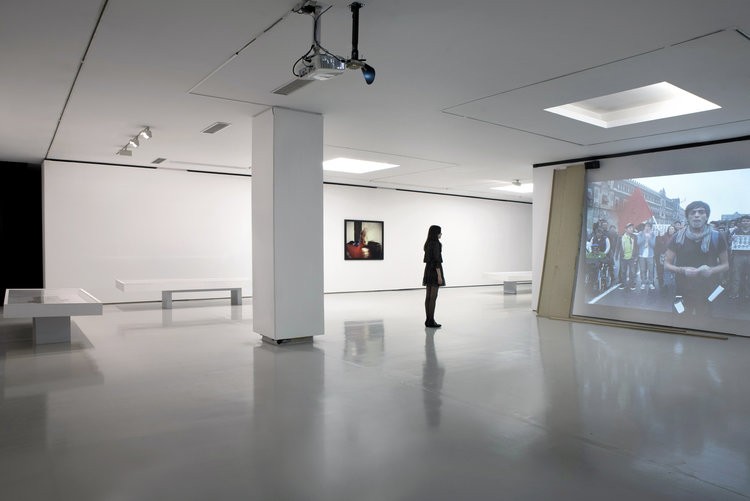Ixone Sádaba
En Este Lugar, 138 Veces
10 Oct 2017 - 14 Jan 2018
IXONE SÁDABA
En Este Lugar, 138 Veces
10 October 2017 - 14 January 2018
Unearthing an anarchaeological site
A place is a living testimony and its form is the product of an ideology. Thus, the different forms that a place adopts over time act as an archaeology of its own history and of the items and bodies that have occupied it. Ideological fossils that, despite embodying the past, are here in the present. A sort of skin of skins covers this site, the overly nude body of an exhibition area.
The exhibition takes you through the intentional act of eradicating. As nothing disappears just because, but rather as the result of a conscious exercise: "A single animal can make countless gestures throughout its lifetime, but can only leave one body behind. This is nothing new (Walter Benjamin did warn us: "to live means to leave traces "), but perhaps it is a useful reminder of what quickly disintegrates, and what, by its structure, refuses to disappear.” 1
A sign of the times, the "document" has achieved a strong cultural and social relevance nowadays. Yet there is always conflict between the narration of an event and the occurrence itself (even more so if the occurrence itself is already conflictive). The account that seeks to falsify the reality is not the same as the account that seeks to reveal through fiction (the novel). Fiction is not a lie and has no intention of deceiving anybody."
Sometimes we live the wars between nations as personal events. Sometimes a private drama appears like a war or natural catastrophe. Sometimes the two wars, the personal and the national, coincide. Sometimes there is peace on one side (in one's heart) and war on the other. I and the world are never separate. The one is the double or metaphor of the other.“2
The state of time with its whole routine and banal dimension, that is even personal and scientific, now returns to the exhibition area in a different way, beyond mere rendering.
The fading of the visual also means its opening.
Ixone Sádaba
THE ARTIST www.ixonesadaba.com
Ixone Sádaba (Bilbao, 1977) fundamentally uses photography, installation and performance to explore the notions of the rendering and perception of identity. Her work presents an analysis of the morphology and of the formal development of representation as an ideological construction. Furthermore, photography acts as a field study through which Sádaba questions the dimension of the glance, over and beyond the regulatory framework that defines or seeks to define an image.
Sádaba points out that the documentary and formal aspects of photography have been used to support regulatory knowledge for many years, and she proposes an approach to the medium in which materialities and tools are deployed, a place to expand and shrink time-space, to alarm and differ.
After graduating with a degree in fine arts from the University of the Basque Country in 2001, Sádaba received her M.A. from Antonio Lebrija University in Madrid (2001) and a postgraduate diploma from the International Center of Photography in New York (2005). Her work has been exhibited in galleries and institutions, including: Reina Sofía Museum, the Guggenheim Bilbao, MUSAC, MOCCA Contemporary Art Museum (Toronto) and Museum of Contemporary Art (New Orleans). She was awarded the Generaciones 2011 Prize for the La Nuit Americaine project and was a finalist of the Sovereign Art Foundation Prize in 2012. Other awards include: Convergencias, Alliance Française & Pilar Citoler Foundation (2012), Sovereign European Art Prize, Hong Kong (2011), Generación 2011, Caja Madrid.Her work is part of the collections of the Guggenheim Bilbao, MNCARS, ARTIUM, MUSAC, Iberdrola, BBK, Madrid Autonomous Community, as well as numerous private ones. Sádaba has held international residencies, including the International Studio & Curatorial Program (ISCP), New York, Delfina Foundation Residency, Mugatxoan Fundaçao Serralves and Arteleku.
1 Catherine Foulkrod, “Do not enter like you always do”. Quoting Walter Benjamin, “Paris, Capital of the Nineteenth Century.” Reflections (New York and London: Harcourt Brace Jovanovich, 1978), 155 . Text displayed in the room as part of the exhibition.
2 Hélène Cixous, preface to The Hélène Cixous Reader, edited by Susan Sellers (New York and London: Routledge, 1994), xv. Quoted by Catherine Foulkrod, “Do not enter like you always do”. Text displayed in the room as part of the exhibition.
En Este Lugar, 138 Veces
10 October 2017 - 14 January 2018
Unearthing an anarchaeological site
A place is a living testimony and its form is the product of an ideology. Thus, the different forms that a place adopts over time act as an archaeology of its own history and of the items and bodies that have occupied it. Ideological fossils that, despite embodying the past, are here in the present. A sort of skin of skins covers this site, the overly nude body of an exhibition area.
The exhibition takes you through the intentional act of eradicating. As nothing disappears just because, but rather as the result of a conscious exercise: "A single animal can make countless gestures throughout its lifetime, but can only leave one body behind. This is nothing new (Walter Benjamin did warn us: "to live means to leave traces "), but perhaps it is a useful reminder of what quickly disintegrates, and what, by its structure, refuses to disappear.” 1
A sign of the times, the "document" has achieved a strong cultural and social relevance nowadays. Yet there is always conflict between the narration of an event and the occurrence itself (even more so if the occurrence itself is already conflictive). The account that seeks to falsify the reality is not the same as the account that seeks to reveal through fiction (the novel). Fiction is not a lie and has no intention of deceiving anybody."
Sometimes we live the wars between nations as personal events. Sometimes a private drama appears like a war or natural catastrophe. Sometimes the two wars, the personal and the national, coincide. Sometimes there is peace on one side (in one's heart) and war on the other. I and the world are never separate. The one is the double or metaphor of the other.“2
The state of time with its whole routine and banal dimension, that is even personal and scientific, now returns to the exhibition area in a different way, beyond mere rendering.
The fading of the visual also means its opening.
Ixone Sádaba
THE ARTIST www.ixonesadaba.com
Ixone Sádaba (Bilbao, 1977) fundamentally uses photography, installation and performance to explore the notions of the rendering and perception of identity. Her work presents an analysis of the morphology and of the formal development of representation as an ideological construction. Furthermore, photography acts as a field study through which Sádaba questions the dimension of the glance, over and beyond the regulatory framework that defines or seeks to define an image.
Sádaba points out that the documentary and formal aspects of photography have been used to support regulatory knowledge for many years, and she proposes an approach to the medium in which materialities and tools are deployed, a place to expand and shrink time-space, to alarm and differ.
After graduating with a degree in fine arts from the University of the Basque Country in 2001, Sádaba received her M.A. from Antonio Lebrija University in Madrid (2001) and a postgraduate diploma from the International Center of Photography in New York (2005). Her work has been exhibited in galleries and institutions, including: Reina Sofía Museum, the Guggenheim Bilbao, MUSAC, MOCCA Contemporary Art Museum (Toronto) and Museum of Contemporary Art (New Orleans). She was awarded the Generaciones 2011 Prize for the La Nuit Americaine project and was a finalist of the Sovereign Art Foundation Prize in 2012. Other awards include: Convergencias, Alliance Française & Pilar Citoler Foundation (2012), Sovereign European Art Prize, Hong Kong (2011), Generación 2011, Caja Madrid.Her work is part of the collections of the Guggenheim Bilbao, MNCARS, ARTIUM, MUSAC, Iberdrola, BBK, Madrid Autonomous Community, as well as numerous private ones. Sádaba has held international residencies, including the International Studio & Curatorial Program (ISCP), New York, Delfina Foundation Residency, Mugatxoan Fundaçao Serralves and Arteleku.
1 Catherine Foulkrod, “Do not enter like you always do”. Quoting Walter Benjamin, “Paris, Capital of the Nineteenth Century.” Reflections (New York and London: Harcourt Brace Jovanovich, 1978), 155 . Text displayed in the room as part of the exhibition.
2 Hélène Cixous, preface to The Hélène Cixous Reader, edited by Susan Sellers (New York and London: Routledge, 1994), xv. Quoted by Catherine Foulkrod, “Do not enter like you always do”. Text displayed in the room as part of the exhibition.



